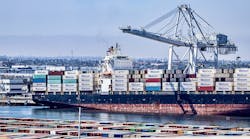No End In Sight for Sky High Shipping Costs
The combination of record-high general rate increases announced by the parcel carriers and most LTL carriers in the fall of 2021, along with ongoing strong pricing power for Truckload, is expected to send transportation costs to record levels in Q1 of 2022. This is according to research released on Jan. 13 by Cowen Research and AFS Logistics.
“Our data and forecasting models indicate that shippers should expect and plan for the higher costs from the last quarter of 2021—which included the peak holiday season—to continue into the first quarter of 2022,” said Tom Nightingale, CEO, AFS Logistics, in a statement. “It’s a perfect storm that’s led to rising shipping rates across the board. When you combine historically high general rate increases with escalating surcharges, the usual mitigating factors such as reduced weight or shorter distance aren’t enough to counterbalance the carrier’s pricing power and the resulting higher rates.”
The Cowen/AFS Freight Index offers a view that leverages both past performance and a machine-learning forecast for the balance of the quarter. The predictions are derived from AFS Logistics’ freight data across transportation modes including truckload, LTL, parcel express and parcel ground sectors.
“The two LTL general rate increases in 2021—one in February and another in November—was a double whammy for shippers,” said Jason Seidl, Cowen’s Senior Analyst for Airfreight & Surface Transportation, in a statement. “This gave carriers significant pricing power and they’re leveraging it.” Seidl also noted “the gap between the published parcel General Rate Increases and realized pricing is as large as we have seen in quite some time which should aid carriers.”
Key Implications for Truckload Shippers
In the last quarter of 2021, pricing power from carriers remained very strong due to the continuing pandemic and robust demand. Mitigating factors such as a 7.3% decrease in average length of haul were not enough to offset rate increases from carriers.
There was a year-over-year increase of 9% in full truckload shipment growth and more demand forced shipments into the spot market with more volatile rates.
Looking into the first quarter of 2022, these conditions will persist. The index is expected to reach a new high of 28.2% compared to the Cowen/AFS Truckload Freight Index baseline of January 2018 and compared to 25.0% in Q4.
Implications for LTL Shippers
There’s a similar outlook for LTL freight. In 2021, carriers announced two GRIs rather than the typical one GRI announced early in the year. Even though weight was decreasing, the cost per shipment increased. Also contributing to the outlook were the punitive accessorial charges for excessive length (ranging from $1,000 to $3,500) implemented in Q4 of 2021 and an increase of 12.4% in fuel surcharges.
These conditions will continue into the first quarter of 2022. Despite the typical seasonal dip, skyrocketing rates will persist through March of 2022. Central Freight Lines ceasing operations in December 2021 has also exacerbated the capacity shortage in the LTL market. In addition, ongoing industry consolidation has resulted in the top 10 carriers now controlling over 70% of all LTL freight—with labor shortages and increased demand. Overall, the Cowen/AFS LTL Freight Index is expected to stay relatively level with Q4 of 2021, with a 35.8% increase compared to the January 2018 baseline.
Implications for Express/Ground Parcel Shippers
In Q4 of 2021, both FedEx and UPS announced the highest ever net-GRI leading into 2022, with a net impact to parcel shippers of 9.2%. For parcel shipping, it’s a very tight pricing environment. Due to capacity constraints and strong demand, carriers are in the position to be selective about which shipments they take on—and which they do not. Also, fuel surcharges have increased, and extra costs are being added for delivery area, residential delivery, additional handling, and peak surcharges. For the full year in 2021, residential shipments accounted for nearly 30% of total shipments, which is a 32% increase compared to the 2018 baseline.
For Express Parcel shipments, the long-term decrease in rate per package was reversed in 2021 due to carrier pricing power and the index returned to 2018 levels. This was due to the increase in actual package weight, tighter carrier pricing policies, the increase in mix of premium services and the 94.4% year-over-year increase in net effective fuel surcharge. With the 2022 GRIs and carrier fuel surcharge increases, the Cowen/AFS Express Parcel Freight Index is expected to climb to 1.4% in Q1 of 2022 vs -5.5% in Q4.
Ground Parcel shipments have experienced a more pronounced increase since 2019. In Q4 of 2021, there was a steep but customary drop in the average billed weight per package during the holiday season. However, there was a marked increase in Ground Parcel rate per package due to the increase in mix of residential shipments, peak surcharges, increased fuel surcharges and tighter pricing controls by the carriers. In Q1 of 2022, the Cowen/AFS Ground Parcel Freight Index continues to increase and is expected to reach an all-time high of 26.3% vs 19.2% in Q4.
For more insights from the January Cowen/AFS Freight Index, visit https://afs.net/cowen-afs-predictive-freight-index.
